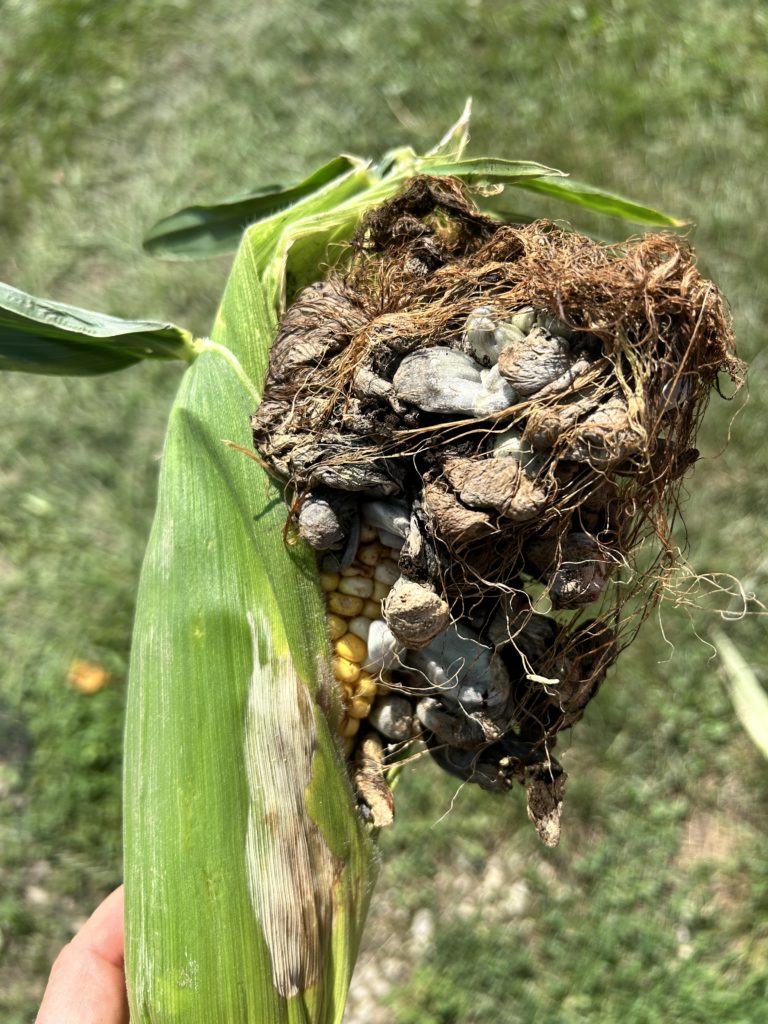Understanding Corn Smut: A Culinary Delicacy and Agricultural Phenomenon
As you wade through all the sweet corn in your CSA share this year, you may discover that one of your ears has corn smut growing on it. If you do, don’t freak out (even though it looks pretty gross!) This fungus is actually a delicacy and highly prized in some cultures. And totally edible. In this article, I’m going to indoctrinate you into the Corn Smut Fan Club, and even give you a recipe to use that mushroom if you are so lucky to find one!
What is Corn Smut?
Corn smut, also known as Ustilago maydis or “huitlacoche” in Mexico, is a fungal disease that affects corn. It forms when the fungus invades the kernels, causing them to swell and develop into bulbous, grayish-black galls filled with spores. While many farmers consider it a blight on their crops, certain cultures, particularly in Mexico, regard corn smut as a gourmet ingredient. The fungus thrives in warm, moist conditions and can be triggered by factors like physical damage to the corn, high humidity, or poor crop management.

What Does Corn Smut Look Like?
Visually, corn smut is quite distinctive. It appears as large, swollen, and often misshapen kernels with a dark, powdery interior. To the untrained eye, it might look like a spoiled ear of corn, but to those familiar with it, corn smut is a sought-after delicacy. In Mexico, huitlacoche is harvested and sold in markets, where it is prized for its earthy, smoky flavor, reminiscent of mushrooms. It’s used in a variety of dishes, from tacos and quesadillas to soups and tamales, adding a unique taste that is both rich and complex.
Corn smut has been a staple in Mexican cuisine for centuries, and its value is slowly being recognized in other parts of the world. Chefs and food enthusiasts are beginning to explore its culinary potential, incorporating it into modern dishes that celebrate its distinct flavor profile. While it may be seen as an agricultural pest in some regions, for others, corn smut represents an opportunity to transform what might otherwise be discarded into something delicious and culturally significant. Embracing this fungus not only connects us to traditional culinary practices but also encourages us to see the potential in every part of our harvest.
Preparing corn smut (huitlacoche) for cooking is straightforward but requires a bit of care to ensure you get the best flavor and texture. Here’s how you can prepare it before using it in recipes:
How to Prepare Huitlacoche for Eating:
- Inspect the Huitlacoche:
- When you get fresh huitlacoche, inspect it for any debris or damaged parts. The galls (the swollen, dark parts) should be firm but tender. Discard any overly dry or excessively damaged sections.
- Cleaning:
- Gently rinse the huitlacoche under cold running water to remove any dirt or debris. Be careful not to be too rough, as the galls can be delicate.
- Chopping:
- After cleaning, pat the huitlacoche dry with a paper towel. Then, chop it into small pieces. The size of the pieces will depend on your recipe, but generally, small, bite-sized pieces work well in most dishes.
- Check for any hard or tough parts:
- While chopping, you might come across some tougher, fibrous parts (usually where the galls are attached to the cob). You can remove these tougher parts if they seem too hard or chewy, as they may not cook down well.
- Cook Immediately:
- Huitlacoche is best used fresh, so once it’s cleaned and chopped, you should cook it right away. The flavor is at its peak when it’s fresh, and it doesn’t store well for long periods.
Once prepped, the huitlacoche is ready to be sautéed, added to stews, or used in recipes like the quesadillas mentioned earlier. It pairs well with onions, garlic, and a variety of herbs and spices, enhancing its rich, earthy flavor.
Here’s a recipe for Huitlacoche Quesadillas – a traditional and delicious way to enjoy corn smut.
Huitlacoche Quesadillas Recipe:
Ingredients:
- 1/2 lb fresh huitlacoche (corn smut)
- 1 tablespoon olive oil
- 1 small onion, finely chopped
- 2 cloves garlic, minced
- 1 jalapeño pepper, finely chopped (optional for heat)
- Salt and pepper to taste
- 1/4 teaspoon ground cumin
- 1/4 teaspoon dried oregano
- 8 small corn or flour tortillas
- 1 cup Oaxaca cheese or mozzarella, shredded
- Fresh cilantro, chopped (for garnish)
- Lime wedges (for serving)
Instructions:
- Prepare the Huitlacoche Filling:
- Heat the olive oil in a skillet over medium heat. Add the chopped onion and sauté until softened, about 3-4 minutes.
- Add the minced garlic and jalapeño (if using), and cook for another minute until fragrant.
- Add the fresh huitlacoche to the skillet, breaking it up with a spoon as it cooks. Season with salt, pepper, cumin, and oregano. Cook for about 8-10 minutes, stirring occasionally, until the huitlacoche is fully cooked and tender. Set aside.
- Assemble the Quesadillas:
- Heat a separate skillet or griddle over medium heat. Place a tortilla on the skillet and sprinkle a layer of shredded cheese over one half of the tortilla.
- Spoon a generous amount of the huitlacoche filling on top of the cheese, then fold the tortilla in half to enclose the filling.
- Cook for 2-3 minutes on each side, or until the tortilla is golden brown and the cheese is melted.
- Serve:
- Remove the quesadilla from the skillet and keep warm while you repeat the process with the remaining tortillas.
- Garnish with fresh cilantro and serve with lime wedges on the side. Enjoy your huitlacoche quesadillas hot, with a squeeze of lime juice for an extra burst of flavor.
This recipe highlights the earthy, mushroom-like flavor of huitlacoche, complemented by the creamy cheese and warm tortillas. It’s a perfect introduction to this unique ingredient!
